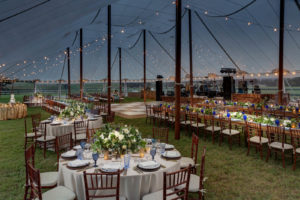 The standard, no-frills tent may be white, but Tentnology Co. Vice President Suzanne Warner likens it to the quintessential little black dress when she talks about a client in Belize who has 50 standard tents and “hundreds and hundreds of assorted accessories.”
The standard, no-frills tent may be white, but Tentnology Co. Vice President Suzanne Warner likens it to the quintessential little black dress when she talks about a client in Belize who has 50 standard tents and “hundreds and hundreds of assorted accessories.”
In addition to custom designs, colors and full digital graphics, the British Columbia-based tent manufacturer customizes “spanners” (banners that run from one tent leg to another), guy sails, viscount sashes and catenary tails to help customers distinguish their tents. The Belize client purchased 200 tent tops and layover stripes, 200 spanners, 200 guy sails and 200 flags for each of his four beverage brands.
“It’s all interchangeable,” Warner says. “It’s like the basic black dress with a different necklace, shoes and handbag. You can add accessories, custom graphics and different fabric elements to customize a structure.”
“The options for customizing are endless because we are working in a space that’s a temporary structure and can be built out to fill the needs of any wedding or corporate planner,” says Jim Gallagher, CEO and president of Partytime-HDO Productions Inc. in Niles, Ill.
“When budgets are flexible, hard walls, flooring, awnings, and valances are nice ways to customize,” says Sarah Miller, event designer for Caplan Miller Events in Austin, Texas. “More cost-effective options are premade tent liners and festoon lighting. I love bringing in wooden walls and flooring for a big transformation. We build steps, columns and door surrounds to match our design aesthetic and incorporate custom canvas awnings over doorways to create dramatic entrances.”
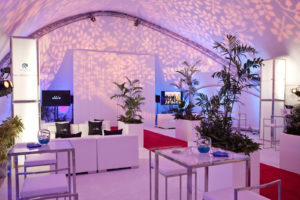
events was customized to fit a specific
footprint. Photo courtesy of Tentnology Co.
Adding texture
For an “entry-level” customization, Gallagher would start with fabric to disguise some of the “not-so-elegant” elements of a tent, such as aluminum poles and purlins.
“That could be done fairly inexpensively,” he says. “Then you can dial it up with full fabric ceilings and walls. The next step is a build-out with hard goods such as lumber, panel walls, Lucite® and floor textiles. AstroTurf® comes in many colors. That’s an option where the upgrade doesn’t cost very much.”
“Tent floors are plywood most of the time. Anything we do beyond that is customization,” says Gauro Coen, general manager at Signature Systems Group LLC. “I have been to the Bahamas for a wedding covering 40,000 square feet with four or five different kinds of flooring. In big tents, I’ve put down expensive Chilewich, which is phenomenal.”
The Dallas, Texas-based manufacturer of tent flooring has installed high-grade carpeting with logo inlays and hardwood floors for car companies attending Concours d’Elegance events and high-end car auctions.
“When companies want to brand on hardwood, it’s generally from a light projection,” Coen says.
“What has become very popular is a [couple] designing a personal message that might include a date or their names,” he adds. “We’ll install a runner down the aisle with that design in the middle. After the wedding, I’ll make it into a 4-by-4-foot rug, put a backing on it, and send it to them. It’s a keepsake they love showing off.”
Location often guides how flooring should be customized to the event. For example, Coen says, sea grass provides the right vibe for a beach wedding.
“It all comes down to budget,” he says. “A large company will hire an agency to manage an event. The agency will send me a rendering of what they would like the space to be. Then I will suggest the flooring to realize their rendering.”
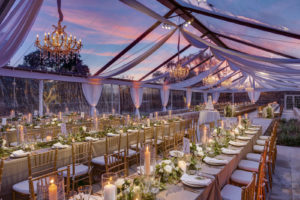
Photo by Jerry Hayes Photography.
Fabrication
For those with large budgets who want an entirely couture structure, the sky is the limit.
“For a high-end wedding, we had all-black tents. They didn’t want to see the tents at night, so it would feel like an alfresco wedding,” says Christopher B. Starr, vice president of Starr Tent in New Rochelle, N.Y. “We also have customized tent tops to allow tree trunks or branches to go through them so the tent can be in a specific location. We did that for a wedding in New York City around 20-foot-tall trees.”
Midrange budget clients often ask for new clear tops. That may not sound like customization at first blush, but it is to the extent that they’re asking for something not in a tent renter’s inventory.
“The client pays a portion of the manufacturing cost to get something that has never been used,” Starr says.
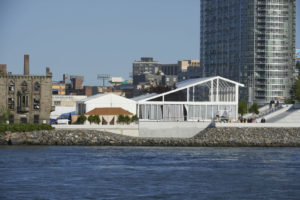
There are nonstandard options for limited budgets too.
“We use equipment that’s off the shelf and add some custom sections, making the tent fit around obstructions like planting beds in a courtyard,” Starr says. “We keep the cost as low as possible for the customer while maximizing the space.”
Digitally printed graphics may be the ultimate form of customization.
“We did a 10,000-square-foot security checkpoint tent for an NBA All-Star Game in Brooklyn,” Starr says, noting that adidas sponsored custom panels with images of players and logos on sidewalls and gable ends.
“The printing technology on tents since I started in this industry 40 years ago has come from hand painting to full digital printing,” says Brad Gleason, president for Economy Tent International. Most of the digital printing done by the Miami, Fla.-based manufacturer is for event marketing.
“It might be an advertisement for a beer company along with the name of a festival, so that tent could only be used for that event,” Gleason says. “The money comes from sponsorships. If the sponsorship changes, they have to buy new tent tops. Or the name of the festival might change. The Magnolia Festival may become the Sugar Plum and Magnolia Festival.”
Car manufacturers, known for touring ride-and-drive events, also are a prime example of the custom-printed-tent clientele, he adds.
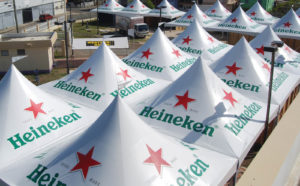
“The biggest trend in the special event industry as a whole is customization,” Miller says. “All of our clients are looking to create a unique experience that sets their event apart from the rest.”
“The whole point of customization is that everybody is a little different,” Warner says.
“We are doing a massive custom structure, everything from powder coating the aluminum to unique graphics to coming up with new designs for a three-dimensional wall,” she says. “The client wants the membrane to not look like a tent.”
Warner notes that clients wanting customized structures often change their requirements without changing their timeframes.
“As frustrating as it may be, I have to thank them for challenging us,” she says. “Without their demands and expectations, it wouldn’t push us to experiment and innovate and develop in areas that we wouldn’t have.”
Janice Kleinschmidt is a freelance writer based in San Diego, Calif.
 TEXTILES.ORG
TEXTILES.ORG


